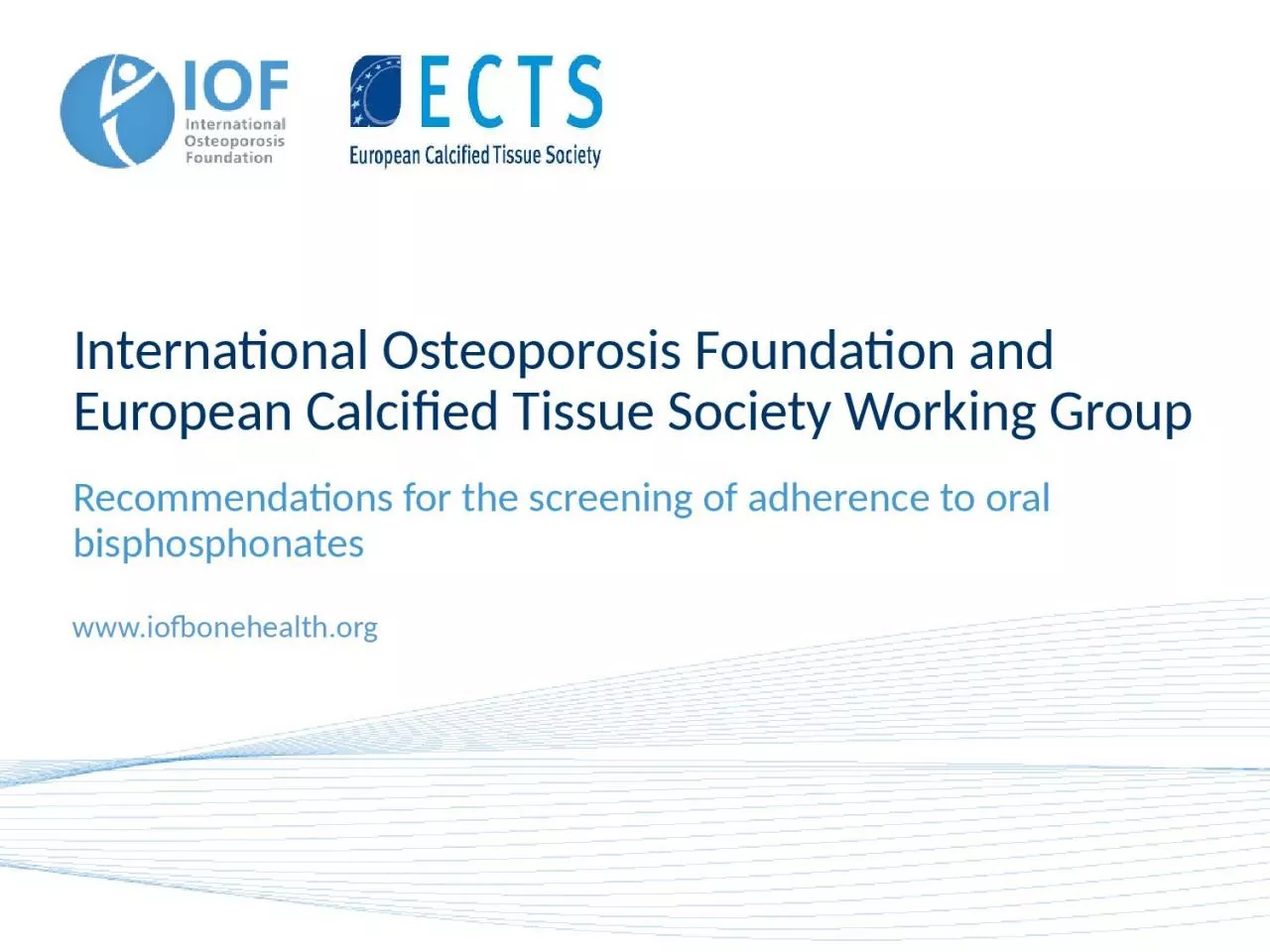

Calcified Tissue Society Working Group Recommendations for the screening of adherence to oral bisphosphonates wwwiofbonehealthorg IOFECTS Working Group Richard Eastell amp Adolfo DiezPerez ID: 1040642
Download Presentation The PPT/PDF document "International Osteoporosis Foundation an..." is the property of its rightful owner. Permission is granted to download and print the materials on this web site for personal, non-commercial use only, and to display it on your personal computer provided you do not modify the materials and that you retain all copyright notices contained in the materials. By downloading content from our website, you accept the terms of this agreement.
1. International Osteoporosis Foundation and European Calcified Tissue Society Working GroupRecommendations for the screening of adherence to oral bisphosphonateswww.iofbonehealth.org
2. IOF-ECTS Working GroupRichard Eastell & Adolfo Diez-Perez (co-chairs)KE Naylor, B Abrahamsen, D Agnusdei, ML Brandi, C Cooper, E Dennison, EF Eriksen, DT Gold, N Guañabens, P Hadji, M Hiligsmann, R Horne, R Josse, JA Kanis, B Obermayer-Pietsch, D Prieto-Alhambra, JY Reginster, R Rizzoli, S Silverman, MC Zillikens
3. Osteoporos Int (2017) 28:767–774
4. BACKGROUND IBisphosphonates (BPs) are considered a first-line treatment of osteoporosisAdherence to BPs has been reported at 50% or below after one year1-3Low adherence results in lack of efficacy (no or limited decrease in fracture risk) and reduced cost effectiveness41. Cramer JA, et al (2007). Osteoporos Int 18(8):1023–1031; 2. Kothawala P, et al (2007). Mayo Clin Proc 82(12):1493–1501; 3. Kanis JA, et al (2012). Osteoporos Int 23(1):213–221; 4. Hiligsmann M et al (2010). Calcif Tissue Int 86(3):202–210
5. BACKGROUND IIBone turnover markers (BTM) reflect the tissue effect of BPs1Measurement of BTM has been proposed for monitoring treatment2Serum CTX and PINP have been recommended as reference markers of bone turnover11. Vasikaran S et al (2011). Osteoporos Int 22(2): 391–420; 2. Kanis JA et al (2013) Osteoporos Int 24(1):23–57
6. Question to be addressed:Can the bone turnover markers PINP and CTX be used to identify low adherence in patients with postmenopausal osteoporosis initiating oral bisphosphonates for osteoporosis?Working Group on Adherence of the IOF and the ECTS
7. METHODS: THE TRIO STUDY (I)The TRIO Study1 was specifically addressing the question raised by the Working GroupRCT of 172 postmenopausal women with osteoporosisEffect of Aln, Ris and Ibn on BTMProportion of cases with decreases in BTM beyond the LSC (2-tailed) at three months1. Naylor KE et al (2016) . Osteoporos Int 27(1):21–31
8. METHODS: THE TRIO STUDY (II)Blood sampling at baseline and several times after starting BPsAdherence evaluated by the Medication Event Monitoring System (MEMS) capsRepresent a benchmark for measuring the effect of treatment on BTM1. Naylor KE et al (2016) . Osteoporos Int 27(1):21–31
9. Effect of BPs on serum CTXLSC threshold
10. Effect of BPs on serum CTXLSC threshold
11. Performance of BTMs for screeningDetection rate: proportion of patients with changes in BTMs that exceed the least significant change when taking oral BPs.Detection rate =A (positive)A (positive) + C (negative)Positive = Cases with a decrease > LSC in one or both BTMNegatives = Cases with decrease < LSC or no decreaseLSC = Least significant change
12. BTM(IDS iSYS)NDecrease>LSC (N)Decrease< LSC (N)Detection Rate(%)CTX1461271986.9PINP1491252483.9CTX + PINP146138894.5DETECTION RATE
13. CRITICAL VALUES FOR PINP AND CTXPINPCTXIDS iSYSRoche Cobas e411IDS iSYSRoche Cobas e411Controls, mean31 μg / L33 μg / L327 ng / L221 ng / LLSC29%23%54%50%LSC6.2 μg / L5.7 μg / L80 ng / L60 ng / LEffect-51 %-54 %-75 %-74 %Effect-28 μg / L-32 μg / L-490 ng / L- 360 ng / LReproduced from Eastell R et al., Diagnosis of endocrine disease: Bone turnover markers: are they clinically useful? Eur J Endocrinol. 2018 178:R19-R31 with permissions from BioScientifica Ltd.
14. ALGORITHM FOR ADHERENCE SCREENINGBaselineBTM(PINP, CTX)3-monthsBTM(PINP, CTX)BTMDecrease > LSCBTMDecrease < LSCTreatmentinitiationReassessTreatmentContinueTreatment
15. IF BTM DO NOT DECREASE…Reassess treatmentOther causesUndetected secondary osteoporosisInterfering medicationsLack of efficacyPoor adherence !!!Treatment stoppedWrong administration
16. Bone turnover markers are efficient for the screening of adherence to oral bisphosphonatesTwo measurements, at the treatment initiation and at month three, are recommendedCONCLUSION
17. The educational slide kit was made possible through an unrestricted grant fromAcknowledgment
18.